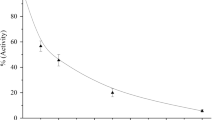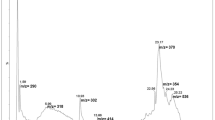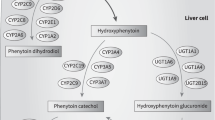Summary
The effect of the dietary flavonoid galangin on the metabolism of 7,12-dimethylbenz[a]anthracene (DMBA), the activity of cytochrome P450 1A1 (CYP1A1), and the expression of CYP1A1 in MCF-7 human breast carcinoma cells was investigated. Galangin inhibited the catabolic breakdown of DMBA, as measured by thin-layer chromatography, in a dose-dependent manner. Galangin also inhibited the formation of DMBA-DNA adducts, and prevented DMBA-induced inhibition of cell growth. Galangin caused a potent, dose-dependent inhibition of CYP1A1 activity, as measured by ethoxyresorufin-O-deethylase activity, in intact cells and in microsomes isolated from DMBA-treated cells. Analysis of the inhibition kinetics by double-reciprocal plot demonstrated that galangin inhibited CYP1A1 activity in a non-competitive manner. Galangin caused an increase in the level of CYP1A1 mRNA, indicating that it may be an agonist of the aryl hydrocarbon receptor, but it inhibited the induction of CYP1A1 mRNA by DMBA or by 2,3,5,7-tetrachlorodibenzo-p-dioxin (TCDD). Galangin also inhibited the DMBA- or TCDD-induced transcription of a reporter vector containing the CYP1A1 promoter. Thus, galangin is a potent inhibitor of DMBA metabolism and an agonist/antagonist of the AhR, and may prove to be an effective chemopreventive agent.
Similar content being viewed by others
Article PDF
Change history
16 November 2011
This paper was modified 12 months after initial publication to switch to Creative Commons licence terms, as noted at publication
References
Bradford, M. (1976). A rapid and sensitive method for the quantitation of microgram quantities of protein utilizing the principle of protein-dye binding. Anal Biochem 72: 248–254.
Buening, M., Chan, R., Huang, M., Fortner, J., Wood, A. & Conney, A. (1981). Activation and inhibition of benzo(a)pyrene and aflatoxin B1 metabolism in human liver microsomes by naturally occurring flavonoids. Cancer Res 41: 67–72.
Canivenc-Lavier, M., Vernevaut, M., Totis, M., Siess, M., Magdalou, J. & Suschetet, M. (1996). Comparative effects of flavonoids and model inducers on drug metabolizing enzymes in rat liver. Toxicology 114: 19–27.
Christou, M., Savas, U., Spink, D., Gierthy, J. & Jefcoate, C. (1994). Co-expression of human CYP1A1 and a human analog of cytochrome P450-EF in response to 2,3,7,8-cells. tetrachlorodibenzo-p-dioxin in the human mammary carcinoma-derived MCF-7 cell. Carcinogenesis 15: 725–732.
Ciolino, H., Daschner, P., Wang, T. & Yeh, G. (1998). The effect of curcumin on the aryl hydrocarbon receptor and cytochrome P450 1A1 in MCF-7 human breast carcinoma cells. Biochem Pharmacol 56: 197–206.
Critchfield, J., Welsh, C., Phang, J. & Yeh, G. (1994). Modulation of adriamycin accumulation and efflux by flavonoids in HCT-15 colon cells. Activation of P-glycoprotein as a putative mechanism. Biochem Pharmacol 48: 1437–1445.
Csokay, B., Prajda, N., Weber, G. & Olah, E. (1997). Molecular mechanisms in the antiproliferative action of quercetin. Life Sci 60: 2157–2163.
Dipple, A. (1995). DNA adducts of chemical carcinogens. Carcinogenesis 16: 437–441.
Dohr, O., Vogel, C. & Abel, J. (1995). Different response of 2,3,7,8-tetrachlorodibenzo-p-dioxin (TCDD)-sensitive genes in human breast cancer MCF-7 and MDA-MB 231 cells. Arch Biochem Biophys 321: 405–412.
Eaton, E., Walle, U., Lewis, A., Hudson, T., Wilson, A. & Walle, T. (1996). Flavonoids, potent inhibitors of the human P-form phenolsulfotransferase. Potential role in drug metabolism and chemoprevention. Drug Metab Dispo 24: 232–237.
Formica, J. & Regelson, W. (1995). Review of the biology of quercetin and related bioflavonoids. Food Chem Toxicol 33: 1061–1080.
Hollman, P. & Katan, M. (1997). Absorption, metabolism and health effects of dietary flavonoids in man. Biomed Pharmacother 51: 305–310.
Hollman, P. & Katan, M. (1998). Bioavailability and health effects of dietary flavonols in man. Arch Toxicol Suppl 20: 237–248.
Hollman, P., van Trijp, J., Mengelers, M., de Vries, J. & Katan, M. (1997). Bioavailability of the dietary antioxidant flavonol quercetin in man. Cancer Lett 114: 139–140.
Huggins, C., Grand, L. & Brillantes, F. (1961). Mammary cancer induced by a single feeding of polynuclear hydrocarbons, and its suppression. Nature 189: 204–207.
Jellinck, P., Forkert, P., Riddick, D., Okey, A., Michnovicz, J. & Bradlow, H. (1993). Ah receptor binding properties of indole carbinols and induction of hepatic estradiol hydroxylation. Biochem Pharmacol 45: 1129–1136.
Kao, Y., Zhou, C., Sherman, M., Laughton, C. & Chen, S. (1998). Molecular basis of the inhibition of human aromatase (estrogen synthetase) by flavone and isoflavone phytoestrogens: a site-directed mutagenesis study. Environ Health Perspect 106: 85–92.
Kennedy, S. & Jones, S. (1994). Simultaneous measurement of cytochrome P450 1A catalytic activity and total protein concentration with a fluorescence plate reader. Anal Biochem 222: 217–223.
Kono, Y., Kobayashi, K., Tagawa, S., Adachi, K., Ueda, A., Sawa, Y. & Shibata, H. (1997). Antioxidant activity of polyphenolics in diets. Rate constants of reactions of chlorogenic acid and caffeic acid with reactive species of oxygen and nitrogen. Biochim Biophys Acta 1335: 335–342.
Kuhnau, J. (1976). The flavonoids. A class of semi-essential food components: their role in human nutrition. World Rev Nutr Diet 24: 117–191.
Lamartiniere, C., Moore, J., Brown, N., Thompson, R., Hardin, M. & Barnes, S. (1995). Genistein suppresses mammary cancer in rats. Carcinogenesis 16: 2833–2840.
Larsen, M. C., Angus, W. G., Brake, P. B., Eltom, S. E., Sukow, K. A. & Jefcoate, C. R. (1998). Characterization of CYP1B1 and CYP1A1 expression in human mammary epithelial cells: role of the aryl hydrocarbon receptor in polycyclic aromatic hydrocarbon metabolism. Cancer Res 58: 2366–2374.
Lubinski, J., Flint, O. & Durham, S. (1994). In vivo and in vitro studies of rat liver cytochrome P450 induction: II. In vitro induction by phenobarbitol and 3-methylcholanthrene measured in an automated 24-well plate assay for cytochrome P450-dependent activity (pentoxyresorufin-O-deethylase and ethoxyresorufin-O-deethylase). In Vitro Toxicol 7: 13–23.
Manach, C., Morand, C., Texier, O., Favier, M., Agullo, G., Demigne, C., Regerat, F. & Remsy, C. (1995). Quercetin metabolites in plasma of rats fed diets containing rutin or quercetin. J Nutr 125: 1911–1922.
Miller, S., Dykes, D. & Polesky, H. (1988). A simple salting out procedure for extracting DNA from human nucleated cells. Nucleic Acids Res 16: 1215
Mirzoeva, O. & Calder, P. (1996). The effect of propolis and its components on eicosanoid production during the inflammatory response. Prostaglandins Leukot Essent Fatty Acids 55: 441–449.
Moon, J. Y., Lee, D. W. & Park, K. H. (1998). Inhibition of 7-ethoxycoumarin O-deethylase activity in rat liver microsomes by naturally occurring flavonoids: structure-activity relationships. Xenobiotica 28: 117–126.
Moore, M., Wang, X., Lu, Y., Wormke, M., Craig, A., Gerlach, J., Burghardt, R., Barhoumi, R. & Safe, S. (1994). Benzo[a]pyrene-resistant MCF-7 human breast cancer cells. A unique aryl hydrocarbon-nonresponsive clone. J Biol Chem 269: 11751–11759.
Morton, M., Chan, P., Cheng, C., Blacklock, N., Matos-Ferreira, A., Abranches-Monteiro, L., Correia, R., Lloyd, S. & Griffiths, K. (1997). Lignans and isoflavonoids in plasma and prostatic fluid in men: samples from Portugal, Hong Kong, and the United Kingdom. Prostate 32: 122–128.
Noda, Y., Anzai, K., Mori, A., Kohno, M., Shinmei, M. & Packer, L. (1997). Hydroxyl and superoxide anion radical scavenging activities of natural source antioxidants using the computerized JES-FR30 ESR spectrometer system. Biochem Mol Biol Int 42: 35–44.
Rosenthal, N. (1987). Identification of regulatory elements of cloned genes with functional assays. Methods Enzymol 152: 704
Rowlands, J. & Gustafsson, J. (1997). Aryl hydrocarbon receptor-mediated signal transduction. Crit Rev Toxicol 27: 109–134.
Rubinstein, L., Shoemaker, R., Paull, K., Simon, R., Tosin, S., Skehan, P., Scudiero, D., Monks, A. & Boyd, M. (1990). Comparison of in vitro anticancer-drug-screening data generated with a tetrazolium assay versus a protein assay against a diverse panel of human tumor cell lines. J Natl Cancer Inst 82: 1113–1118.
Shimada, T., Gillam, E. M., Sutter, T. R., Strickland, P. T., Guengerich, F. P. & Yamazaki, H. (1997). Oxidation of xenobiotics by recombinant human cytochrome P450 1B1. Drug Metab Dispos 25: 617–622.
Siess, M., Leclerc, J., Canivenc-Lavier, M., Rat, P. & Suschetet, M. (1995). Heterogenous effects of natural flavonoids on monooxygenase activities in human and rat liver microsomes. Toxicol Appl Pharmacol 130: 73–78.
So, F., Guthrie, N., Chambers, A., Moussa, M. & Carroll, K. (1996). Inhibition of human breast cancer cell proliferation and delay of mammary tumorigenesis by flavonoids and citrus juices. Nutr Cancer 26: 167–181.
So, F., Guthrie, N., Chambers, A. & Carroll, K. (1997). Inhibition of proliferation of estrogen receptor-positive MCF-7 human breast cancer cells by flavonoids in the presence and absence of excess estrogen. Cancer Lett 112: 127–133.
Sogawa, K., Fujisawa-Sehara, A., Yamane, M. & Fujii-Kuriyama, Y. (1986). Location of regulatory elements responsible for drug induction in the rat cytochrome P450c gene. Proc Natl Acad Sci USA 83: 8044–8048.
Sousa, R. & Marletta, M. (1985). Inhibition of cytochrome P450 activity in rat liver microsomes by the naturally occurring flavonoid, quercetin. Arch Biochem Biophys 240: 345–357.
Steinmetz, K. & Potter, J. (1996). Vegetables, fruit, and cancer prevention: a review. J Am Diet Assoc 96: 1027–1039.
Tsyrlov, I. B., Mikhailenko, V. M. & Gelboin, H. V. (1994). Isozyme- and species-specific susceptibility of cDNA-expressed CYP1A P450s to different flavonoids. Biochim Biophys Acta 1205: 325–335.
Verma, A., Johnson, J., Gould, M. & Tanner, M. (1988). Inhibition of 7,12-dimethylbenz-[a]-anthracene- and N-nitrosomethylurea-induced rat mammary cancer by dietary flavonol quercetin. Cancer Res 48: 5754–5758.
Wang, X., Thomsen, J., Santostefano, M., Rosengren, R., Safe, S. & Perdew, G. (1995). Comparative properties of the nuclear aryl hydrocarbon (Ah) receptor complex from several human cell lines. Eur J Pharmacol 293: 191–205.
Wattenberg, L. (1985). Chemoprevention of cancer. Cancer Res 45: 1–8.
Author information
Authors and Affiliations
Rights and permissions
From twelve months after its original publication, this work is licensed under the Creative Commons Attribution-NonCommercial-Share Alike 3.0 Unported License. To view a copy of this license, visit http://creativecommons.org/licenses/by-nc-sa/3.0/
About this article
Cite this article
Ciolino, H., Yeh, G. The flavonoid galangin is an inhibitor of CYP1A1 activity and an agonist/antagonist of the aryl hydrocarbon receptor. Br J Cancer 79, 1340–1346 (1999). https://doi.org/10.1038/sj.bjc.6690216
Received:
Revised:
Accepted:
Published:
Issue date:
DOI: https://doi.org/10.1038/sj.bjc.6690216
Keywords
This article is cited by
-
Quantum Chemical Investigation, Drug-Likeness and Molecular Docking Studies on Galangin as Alpha-Synuclein Regulator for the Treatment of Parkinson’s Disease
Chemistry Africa (2023)
-
Galangin, as a Potential Anticancer Agent
Revista Brasileira de Farmacognosia (2022)
-
In vitro and in vivo studies of 5,7-dihydroxy flavones isolated from Alpinia galanga (L.) against human lung cancer and ascetic lymphoma
Medicinal Chemistry Research (2019)
-
Cytotoxic and potent CYP1 inhibitors from the marine algae Cymopolia barbata
Organic and Medicinal Chemistry Letters (2012)
-
The Bioflavonoid Galangin Suppresses the Growth of Ehrlich Ascites Carcinoma in Swiss Albino Mice: A Molecular Insight
Applied Biochemistry and Biotechnology (2012)



